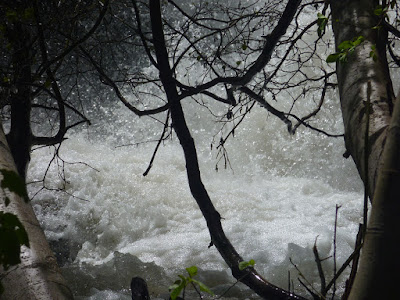From the
Observation Deck of the
Mount Diablo Summit Visitor Center, one has—on a clear day—the perfect view of
North Peak and between-peaks
Prospector's Gap. Farther northeast one can see the
Sacramento-San Joaquin River Delta. To get a closer look at this expansive inland estuary—also known as the
California Delta, or simply the
Delta—the three-mile-long hike across the Diablo slopes and ridges to North Peak is a worthwhile exercise.
From the visitor center, the
Summit Trail leads you to the
Mary Bowerman Trailhead, where, across the Summit Road near the Lower Summit Picnic Area, a short downhill trail connects with the
Devil's Elbow.
The elbow tip is the trailhead of
North Peak Trail. You will see the pleasant path of the single-track trail traveling eastward, traversing an open slope with occasional gray pines toward
Devil's Pulpit. Once half around this
Franciscan-chert monolith, you will enter chaparral and then a low forest of oak, bay laurel and pine trees.
 |
| Gray pines partially damaged by a wild fire |
On a cold and windy day in May 2017, a hummingbird was “greeting” me at a point where creek water was still flowing over the trail. Nearby, I saw
red larkspur flowers, “trying” to attract hummingbirds for pollination. Various other flowers, including California poppies and Chinese houses, displayed their vibrant spring colors alongside this lush section of North Peak Trail.
The northbound trail descends in switchbacks to
Prospector's Gap. From this trail junction,
North Peak Road ascends to North Peak. After half a mile of climbing, you will arrive at a V-junction, from which North Peak Trail continues to
Mount Olympia.

On the left side of the trail you will be face to face with a rusty tank featuring white graffity. To get the top of North Peak, stay on the right-side gravel road and follow the steep incline up to the rugged top with its transmission towers. The posted elevation for North Peak of 3557 feet matches the number given in my “Trail Map of Mount Diablo State Park” designed by Rita Ter Sarkissoff, 2012.
At the northeast corner of North Peak you may want to carefully climb onto “vista rocks” that allow undisturbed views of the Delta and the ridges of the Diablo Range edging Central Valley.
 |
| Northwest-facing slope of North Peak's rugged ridge |
































